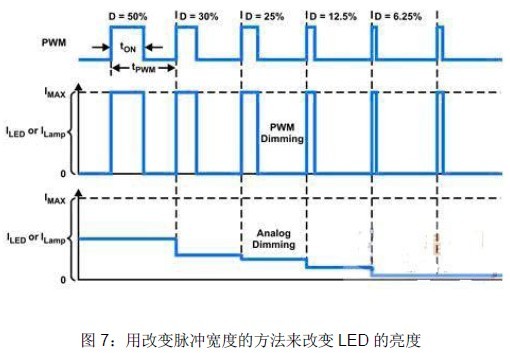The first part adopts the dimming technology of DC power LED
1 Adjust the brightness by adjusting the forward current
To change the brightness of the LED is very easy to achieve. The first thing that comes to mind is to change its drive current because the brightness of the LED is almost directly proportional to its drive current. Figure 1 shows the relative intensity and forward current of Cree's XLampXP-G output.
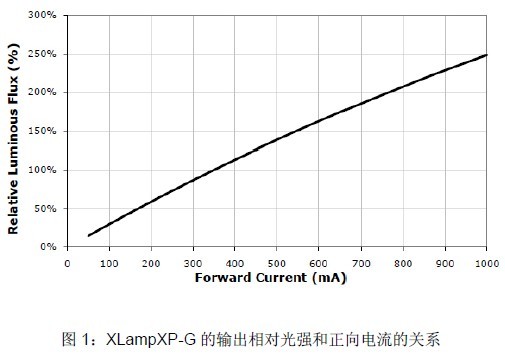
As can be seen from the figure, if the light output at 350 mA is taken as 100%, the light output at 200 mA is about 60%, and at 100 mA is about 25%. Therefore, adjusting the current size makes it easy to adjust the brightness.
1.1.1 Method of adjusting forward current
The easiest way to adjust the LED current is to change the current sense resistor in series with the LED load (Figure 2a). Almost all DC-DC constant current chips have an interface for detecting current, which is the voltage detected and the internal reference of the chip. Voltage comparison to control the current constant. However, the value of this sense resistor is usually very small, only a few ohms. If you want to install a potentiometer of a few ohms on the wall to adjust the current is not possible, because the lead resistance will also have a few ohms. Therefore, some chips provide a control voltage interface, which can change the output constant current value by changing the input control voltage. For example, Linear Technology's LT3478 (Fig. 2b) can change the constant current value of its output as long as the ratio of R1 and R2 is changed.
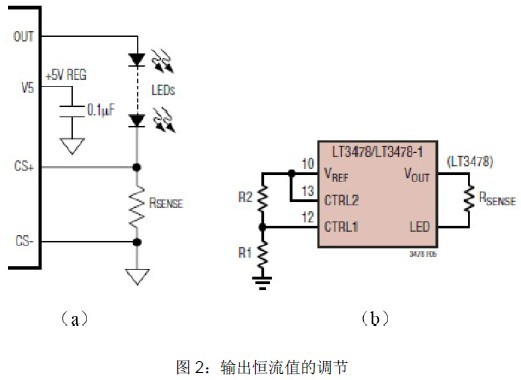
1.1.2 Adjusting the forward current will cause the chromatogram to shift
However, adjusting the brightness by adjusting the forward current causes a problem in that it also changes its spectral and color temperature while adjusting the brightness. Because white LEDs are currently generated by blue LEDs to stimulate yellow phosphors, when the forward current is reduced, the brightness of the blue LEDs increases and the thickness of the yellow phosphors is not scaled down, thereby increasing the dominant wavelength of the spectrum. A specific example is shown in Figure 3.
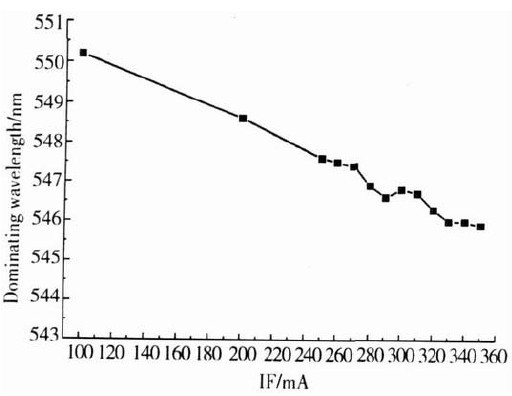
Figure 3: Relationship between dominant wavelength and forward current
When the forward current is 350 mA, the dominant wavelength is 545.8 nm; when the forward current is reduced to 200 mA, the dominant wavelength is 548.6 nm; when the forward current is reduced to 100 mA, the dominant wavelength is 550.2 nm. A change in forward current also causes a change in color temperature (Figure 4).
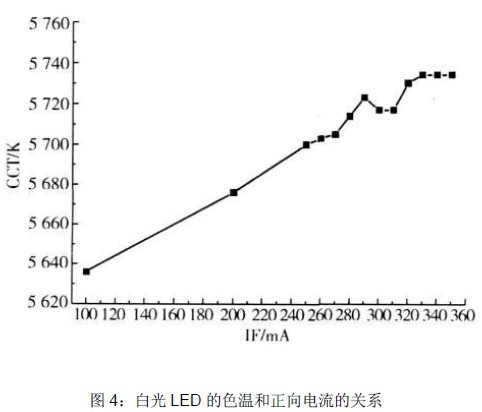
As can be seen from Fig. 4, when the forward current is 350 mA, the color temperature is 5734K, and when the forward current is increased to 350 mA, the color temperature is shifted to 5636K. When the current is further reduced, the color temperature changes to a warm color. Of course, these problems may not be a big problem in general actual lighting. However, in the RGB LED system, color shift is caused, and the human eye is very sensitive to color deviation, and therefore is not allowed.
1.1.3 Adjusting the current will cause serious problems that make the constant current source unable to work.
However, in the specific implementation, dimming by using the forward current method may cause a more serious problem.
We know that LEDs are usually driven by a DC-DC constant current drive source, which is usually divided into a boost or buck type (of course, a buck-boost type, but due to low efficiency , the price is expensive and not commonly used). Whether the boost type or the step-down type is used is determined by the relationship between the power supply voltage and the LED load voltage. If the power supply voltage is lower than the load voltage, the boost type is used; if the power supply voltage is higher than the load voltage, the step-down type is adopted. The forward voltage of the LED is determined by its forward current. From the volt-ampere characteristics of the LED (Fig. 5), it is known that a change in the forward current causes a corresponding change in the forward voltage. Specifically, a decrease in the forward current also causes a decrease in the forward voltage. Therefore, when the current is turned down, the forward voltage of the LED is also reduced. This will change the relationship between the supply voltage and the load voltage.
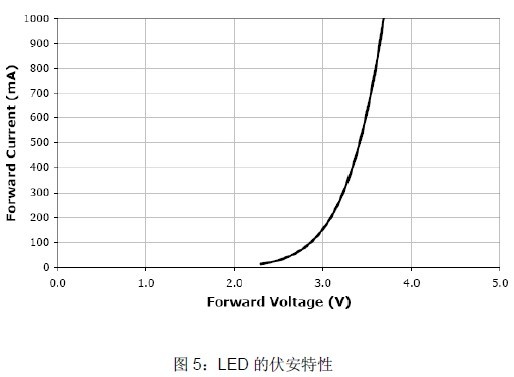
For example, in an LED lamp with an input of 24V, eight 1W high-power LEDs are connected in series. At a forward current of 350 mA, the forward voltage of each LED is 3.3V. Then 8 series is 26.4V, which is higher than the input voltage. Therefore, a boost type constant current source should be used. However, in order to dim, the current is reduced to 100 mA. At this time, the forward voltage is only 2.8V, and the 8 series is 22.4V, and the load voltage becomes lower than the power supply voltage. In this way, the boost constant current source cannot work at all, but the buck type should be used. For a boost-type constant current source, it must not work for buck, and finally the LED will flicker. In fact, as long as the boost type constant current source is used, when the dimming current is adjusted, the flicker phenomenon is almost always generated as long as the brightness is adjusted to a very low level. Because the LED load voltage at that time must be lower than the supply voltage. Many people do not understand the problems, but also always go to the dimming circuit to find the problem, it is useless.
There is less problem with the buck constant current source, because if the original supply voltage is higher than the load voltage, when the brightness is low, the load voltage is reduced, so a buck constant current source is still needed. However, if the very low forward current is adjusted, the load voltage of the LED becomes very low. At that time, the step-down ratio is very large, and it may exceed the normal working range of the buck constant current source, and it will also make it Can't work and produce flicker.
1.1.4 Long-time operation at low brightness may reduce the efficiency of the buck-type constant current source and increase the temperature rise without working.
The average person may think that downward dimming is to reduce the output power of the constant current source, so it is impossible to cause the power consumption of the buck constant current source to increase and the temperature rise to increase. It is not known that the decrease in forward voltage caused by the reduction of the forward current causes the step-down ratio to be lowered. The efficiency of the buck constant current source is related to the buck ratio. The larger the buck ratio, the lower the efficiency, and the greater the power consumption of the loss on the chip. Figure 6 is a plot of efficiency versus step-down ratio for the SLM2842J.

The input voltage in the figure is 35V, the output current is 2A, and when the output voltage is 30V, the efficiency can be as high as 97.8%. However, when the output voltage is reduced to 20V, the efficiency is reduced to 96%; when the output voltage is reduced to 10V, the efficiency is reduced to 92%. In these three cases, although the output power is 60W, 40W and 20W, the power loss is 1.2W, 1.6W, and 1.6W. In the latter two cases, the power consumption increased by 33%. If the cooling system of the constant current module is designed to be very critical, increasing the dissipated power by 33% may increase the junction temperature of the chip, resulting in over-temperature protection and failure to work. In severe cases, the chip may be burnt.
1.1.5 Adjusting the forward current cannot achieve precise dimming
Because the forward current and the light output are not completely proportional, and different LEDs have different forward current and light output curves. Therefore, it is difficult to achieve accurate light output control by adjusting the forward current.
2 Dimming with Pulse Width Modulation (PWM)
The LED is a diode that enables fast switching. Its switching speed can be as high as microseconds or more. It is unmatched by any light-emitting device. Therefore, as long as the power supply is changed to a pulse constant current source, the brightness can be changed by changing the pulse width. This method is called pulse width modulation (PWM) dimming. Fig. 7 shows the waveform of such pulse width modulation. If the period of the pulse is tpwm and the pulse width is ton, then its duty ratio D (or ratio of holes) is ton/tpwm. Changing the duty ratio of the constant current source pulse can change the brightness of the LED.
